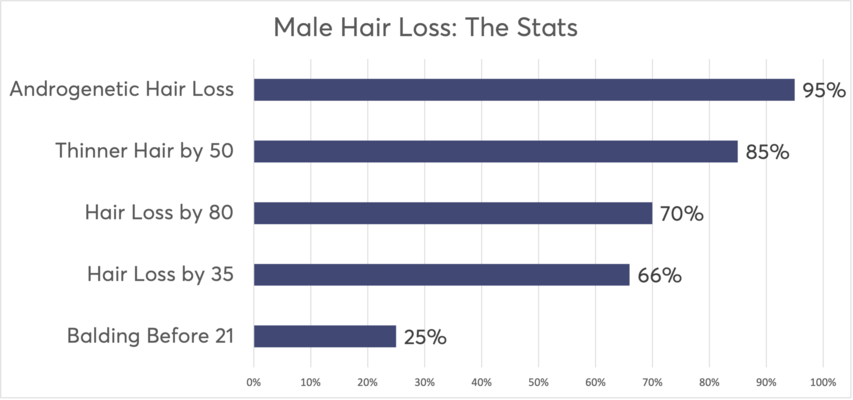Minoxidil vs. Finasteride vs. MDhair

Hair loss can be a distressing experience for men after 40, and finding the proper treatment is crucial. This comprehensive guide will explore three popular male pattern hair loss options: minoxidil, Finasteride, and MDhair. Understanding how each treatment works, its effectiveness, and its unique features will help you decide the best approach for your hair loss concerns.
Understanding Male Pattern Hair Loss
Male pattern baldness, also known as androgenetic alopecia, is men's most common type of hair loss. It is characterized by a receding hairline and thinning hair on the crown. This condition is primarily caused by a combination of genetic and hormonal factors, particularly the hormone dihydrotestosterone (DHT). As DHT binds to hair follicles over time, it can cause them to miniaturize, resulting in shorter and finer hair strands. Understanding the underlying causes and progression of male pattern hair loss is the first step in selecting an appropriate treatment.
Minoxidil: How Does it Work?
Minoxidil, commonly known by the brand Rogaine, is a topical medication applied directly to the scalp. It works by widening blood vessels, improving blood flow to the hair follicles, and potentially stimulating hair growth. While the exact mechanism of action is not yet fully understood, minoxidil is thought to extend the growth phase of hair follicles (anagen phase) and increase their size.
Potential Side Effects of Minoxidil
While generally well-tolerated, minoxidil may cause side effects in some individuals. The most common side effects include scalp irritation, dryness, and itching. In rare cases, minoxidil may also cause unwanted hair growth in areas other than the scalp. It is essential to follow the application instructions and consult a healthcare professional if any adverse reactions occur.
Minoxidil Resistance
Minoxidil resistance, often seen in 15-40% of users, occurs primarily due to insufficient activity of the SULT1A1 enzyme (also known as Sulfotransferase Family 1A Member 1) in the hair follicles. This enzyme is essential for converting the inactive form of minoxidil into its active form, stimulating hair growth. The Minoxidil Response Test (MRT), $139, helps predict an individual's response to minoxidil by measuring the SULT1A1 enzyme levels through a simple process where participants pluck six hairs and send them to a laboratory in a pre-paid envelope. Results, available within 7-14 days, determine the enzyme's activity level, indicating how effectively minoxidil might treat hair loss.
As the MDhair products and Finasteride work differently than minoxidil, people who are resistant to minoxidil are not expected to be resistant to their effect. Minoxidil targets the blood circulation in the scalp. MDhair products include DHT-blocking ingredients that counteract the effects of DHT, and micronutrients that are needed to improve scalp health and provide the building blocks needed for hair regrowth.
How Does Finasteride Work?
Finasteride, commonly sold under the brand name Propecia, is an oral medication that works by inhibiting the enzyme 5-alpha reductase. This enzyme converts testosterone into dihydrotestosterone (DHT), the hormone primarily responsible for hair loss in individuals with a genetic predisposition. By reducing DHT levels, Finasteride helps to slow down hair loss and, in some cases, promotes regrowth.
Effectiveness of Finasteride for Male Pattern Hair Loss
Finasteride has been extensively studied and has demonstrated significant effectiveness in treating male pattern hair loss. Clinical trials have shown that Finasteride can reduce hair loss, increase hair regrowth, and improve hair density. The most significant benefits are typically seen after using Finasteride for at least six months to one year.
Potential Side Effects of Finasteride
While Finasteride is generally well-tolerated, it may cause some side effects in a small percentage of users. The most commonly reported side effect is sexual dysfunction, such as decreased libido or erectile dysfunction. It is important to discuss potential side effects with a healthcare professional before starting Finasteride and report any concerning symptoms promptly.

MDhair: The World's First Customized Hair Loss Treatment
What Makes MDhair Unique?
MDhair is a groundbreaking hair loss treatment system that stands out due to its customization and comprehensive approach. It utilizes AI technology to personalize treatment based on an individual's specific type and severity of hair loss. MDhair combines FDA-approved medications with dermatologist-formulated botanicals, adaptogens, probiotics, and peptides to optimize efficacy and safety. The treatment also includes free and unlimited access to one-on-one chat support with a dermatologist for any questions or concerns.
How Does MDhair Work?
MDhair uses a diagnostic quiz that considers age, hair and health goals, stress levels, and more. Additionally, image capture of the scalp allows continuous monitoring of the treatment progress. The MDhair medical team then uses the data collected to fine-tune medications and provide personalized treatment recommendations.
Comparing Minoxidil, Finasteride, and MDhair:
Several factors come into play when comparing minoxidil, Finasteride, and MDhair. Each treatment has its unique benefits and considerations. Minoxidil is easily accessible over-the-counter, has minimal side effects, and can effectively promote hair regrowth. On the other hand, Finasteride requires a prescription and may have sexual side effects in a small percentage of users, but it has shown significant effectiveness in treating hair loss. MDhair offers a personalized approach, combining FDA-approved medications with dermatologist-formulated botanicals and providing access to medical support.
FAQs:
Q1: How long does it take to see results with minoxidil?
A1: Results with minoxidil can vary, but visible improvements are usually noticed after a few months of consistent use. It is essential to continue using minoxidil as directed to maintain the results.
Q2: Can minoxidil regrow hair on a completely bald scalp?
A2: Minoxidil is most effective at regrowing hair in areas with thinning or miniaturized hair follicles. It may not be as effective in regrowing hair in completely bald spots.
Q3: Is finasteride only for men?
A3: Yes, Finasteride is primarily prescribed for male pattern hair loss. It is not recommended for use in women, particularly those who are pregnant or planning to become pregnant.
Q4: Can Finasteride reverse hair loss completely?
A4: Finasteride can slow down or halt the progression of hair loss in many cases. However, its ability to change hair loss completely varies among individuals and depends on various factors.
Q5: How long should I use Finasteride to see results?
A5: It may take several months of consistent use before visible improvements are noticed. Continued usage is usually necessary to maintain the results.
Q6: Is MDhair suitable for women with hair loss?
A6: MDhair offers customized treatment solutions for both men and women experiencing hair loss. The treatment addresses specific causes of hair loss in women, such as genetic factors, post-partum hair loss, menopause-related hair loss, stress-related hair loss, and diet-related hair loss.
Q7: Does scientific research back the botanical ingredients in MDhair?
A7: MDhair combines dermatologist-formulated botanicals that have been carefully selected based on scientific evidence supporting their efficacy in promoting scalp health and hair regrowth.
Q8: Can I use minoxidil and Finasteride together?
A8: Some individuals may use minoxidil and Finasteride together for a combined approach to hair loss treatment. It is essential to consult a healthcare professional before combining medications to ensure safety and proper usage.
Q9: Is MDhair suitable for all types of hair loss?
A9: MDhair's customized treatment approach allows it to address various types and causes of hair loss. However, it is essential to consult a dermatologist or healthcare professional to determine if MDhair suits your specific condition.
Q10: How long does it take to see results with MDhair?
A10: Results with MDhair can vary depending on individual factors and the severity of hair loss. Visible improvements are typically noticed within several months of consistent use, but continuing the treatment as directed is recommended for optimal results.
Conclusion:
Male pattern hair loss can significantly impact one's self-esteem and confidence. Understanding the available treatment options is essential in finding a solution that best suits your needs. Minoxidil, Finasteride, and MDhair each offer unique benefits and considerations. Minoxidil is easily accessible and can be effective in promoting hair regrowth. Finasteride has shown significant effectiveness but may have sexual side effects in a small percentage of users. MDhair provides a personalized approach with access to medical support and combines FDA-approved medications with dermatologist-formulated botanicals. Consultation with a healthcare professional is recommended to determine the most suitable treatment option for your condition. Remember, consistency and patience are key when addressing male pattern hair loss, and results may vary from person to person.
More info:
- Male Hair Loss: Best Treatments
- Food, DHT, and Male Hair Loss
- What Causes Hair Loss in Men According to Dermatologists?
- What is the best natural treatment for hair loss in men?
References:
Clinical utility and validity of minoxidil response testing in androgenetic alopecia
Sulfotransferase activity in plucked hair follicles predicts response to topical minoxidil in the treatment of female androgenetic alopecia.
Novel enzymatic assay predicts minoxidil response in the treatment of androgenetic alopecia.
Sulfotransferase SULT1A1 activity in the hair follicle, a prognostic marker of response to the minoxidil treatment in patients with androgenetic alopecia: a review
Find the most effective hair growth products for you by taking the free hair assessment.



